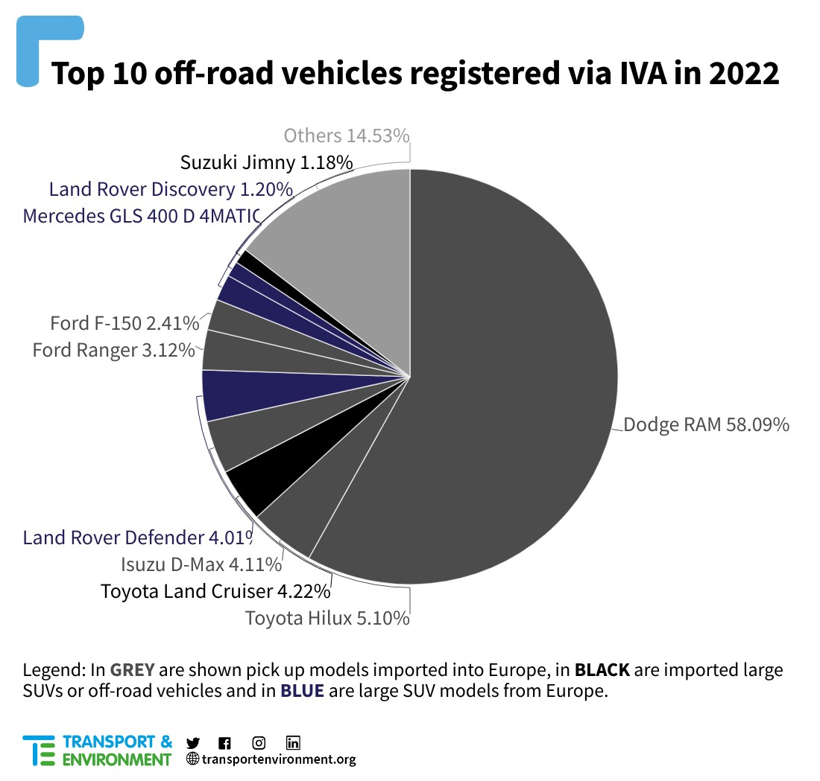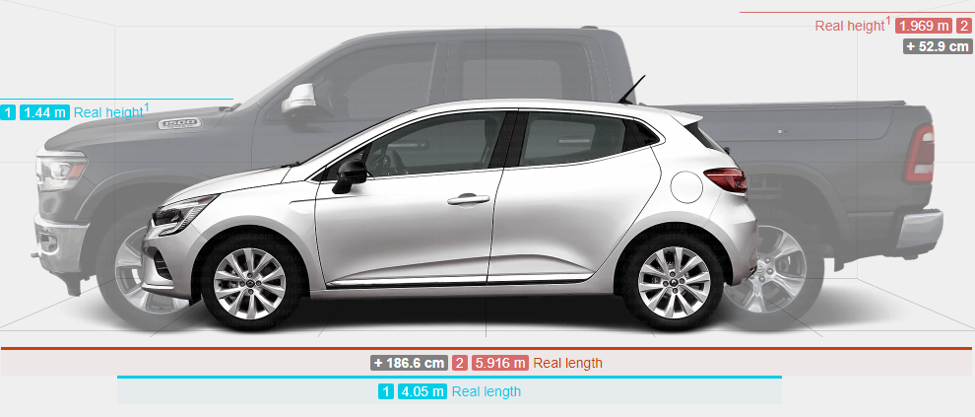In the next months, the European Commission expert group on motor vehicles is expected to convene to discuss and vote on a regulatory gap that threatens the safety of our roads and our environment. This is a tale of unchecked dangers, environmental recklessness, and a call to close the dire loophole before it inflicts more harm.
On October 12, an alliance of safety, consumer and green groups sent a joint letter to the European Commission to call on the EU to end loopholes that allow dangerous American-style pick-up trucks to be sold in Europe.
The alarming surge in imported massive pickup trucks
Under today’s EU vehicle registration system there is an route called Individual Vehicle Approval (or IVA), which is being abused to allow oversized, gas-guzzling vehicles from outside the EU to be imported and registered on European roads without adhering to the EU minimum safety or environmental standards required of vehicles.
One of the most distressing consequences of the IVA loophole is the alarming surge in the registration of imported pickups in Europe. The number of pickups and oversized vehicles registered through the IVA system has surged, increasing from 2,900 units in 2019 to 6,800 units in 2022, marking a 2.3-fold increase [1]. The vast majority of these vehicles imported from the USA, are first registered in Germany and then re-sold on other EU markets.

Off-road van vehicles registered via IVA in 2022 (Source: EEA)
The troubling case of the Dodge Ram
The rise of the Dodge Ram serves as a stark illustration of this worrying trend – making up 60% of IVA imports. Manufactured in North America by the EU-based Stellantis group, the sales of Dodge Rams have more than doubled between 2019 and 2022, going from 1,800 to 4,100 units, totalling 14,000 units over this period. These massive pick-up trucks, weighing an average of close to 2,600 kg, emit an average of 333 gCO2/km – a staggering 3 times more than the EU carmaker’s CO2 fleet average. Moreover, they are behemoths on our roads, capable of intimidating most road users, measuring nearly 6 meters in length, 2 meters in height, and up to 260 cm in width (with mirrors) – far too big for our urban environments [2].

Figure: Dodge Ram size versus Renault Clio, source: carsized.com
Dangerous and dirty but unchecked
The IVA approval route allows vehicles imported and approved via IVA to bypass basic EU environmental and safety regulations for cars. Notably, these vehicles are not required to comply with the 2019 EU General Safety Regulation (GSR), the EU car and van CO2 standards, or the on-road toxic pollutant tests, which all represent fundamental pillars of European vehicle safety and climate goals.
There is simply no justification for permitting the importation of such series-produced vehicles, which are unsuitable for European use, especially when a wide array of EU type-approved vehicles that satisfy all use cases is readily available.
Pick-up trucks are lethal. Large pickups and SUVs like the Dodge Ram are significantly more likely to cause severe injuries and fatalities to pedestrians and cyclists in the event of an accident, notably because of very bad direct vision. Recent research based on five years of Belgian crash data found that pedestrians or cyclists struck by a pick-up truck are almost twice as likely to suffer a serious injury, while their risk of being killed is three times higher compared to a regular car collision.
Lawmakers must lead without further delay
It is high time for the EU to take action and close this detrimental loophole. The only good news in this otherwise tragic story is the opportunity to quickly reverse the problem here. The relevant arm of the European Commission, DG GROW, can put the reform of IVA on the agenda of the EU’s Motor Vehicle Working Group without further delay. Regulators should establish a single safety and environmental standard for the entire EU market, eliminating any backdoor for unsuitable and unsafe vehicles.
Imports of massive pick-ups through the IVA loophole also puts attention on the EU’s maximum width for light duty vehicles. It stands at 255 cm, having been set for trucks and buses, and is in fact facilitating – rather than preventing – the ongoing expansion of pick-ups and large SUVs. If left unchanged, pick-ups and large SUVs will become as wide as trucks and buses.
For that reason the EU should commit to reviewing the maximum width of light duty vehicles. In the revision of the Weights & Dimensions Directive, currently underway, a number of MEPs have already backed such a review. EU decision-makers will hold first votes on width limit early next year and can put a stop to the trend of ever widening SUVs – and with it lethal pick up imports.
Notes
[1] Source: EEA van registration data, 2019-2022
[2] From https://carsized.com/ and https://www.ramtrucks.com/assets/pdf/specsheet/ram_1500_dimensions.pdf. Width is 202 cm.


